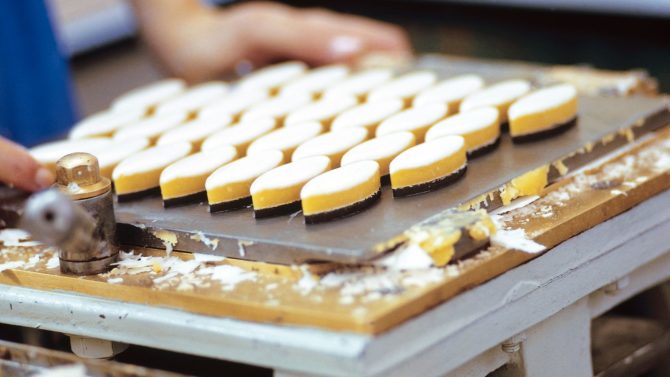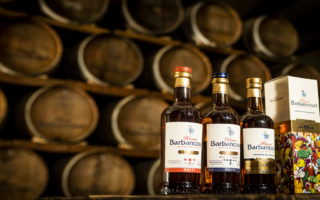French icon: The delicious history of calissons d’Aix

What would you say is the icon of Aix-en-Provence? Paul Cézanne, perhaps! The post-Impressionist painter certainly made this sun-kissed city, dominated by the Mount Sainte Victoire, his home and his muse. But from behind the honey-hued facades and pale blue shutters comes a diamond-shaped sweet, small in size but huge in taste and tradition, that proudly challenges the artist to the podium.
Made from syrupy candied melon and ground almonds and finished with a layer of immaculate icing, the calisson d’Aix is as delicate as an almond blossom. So precious it is to Provençal people that they have invited it to their traditional Christmas table, where it sits among nougats, dried fruits and the orange blossom infused pompe à l’huile. Registered at the Patrimoine de la Ville d’Aix-en-Provence, it is an icon of Provençal and French gastronomy.

Tales and traditions surrounding calissons d’Aix
The legends that surround the creation of the calisson d’Aix are as delicious as the sweet itself. Some date back to Ancient Rome or Greece where dried fruit was combined with almonds to make calisone or kalitsounia. The most exciting tales, however, have a distinctively Provençal accent!
With the first one, we travel back to 1454, to the alliance of Roi René, Duc d’Anjou and Comte de Provence, to the beautiful but famously austere Jeanne de Laval. For the occasion, a local confectioner, perhaps even the King’s own, would have created a confection so regal that the new queen, bringing it to her lips, would have finally smiled and exclaimed in Provençal language, “Di calin soun!” (They are like hugs!) This would eventually become “calisson”. In other versions of the story, a courtesan is said to have exclaimed these words or maybe the Roi René himself. Nevertheless, whoever made this declaration was right: calissons are like hugs! Perhaps therefore, the diamond shape is in fact a smile, the smile of Queen Jeanne. Or perhaps the cradle of baby Jesus, as the calisson d’Aix also has religious origins.
In 1630, the plague was making its ravaging way through the South of France. Joseph Martelly, a county assessor, pleaded to the Vierge de la Seds, patron-saint of Aix-en-Provence, to protect the people of her city and vowed to distribute to them some calissons. When came the end of the epidemy, the assessor honoured his vow in a yearly office of gratitude.
Every first day of September, almond treats previously blessed by the archbishop would be distributed to the congregation in place of communion wafers. The priest would beckon them to the chalice that carried the goods by calling, “Venite ad calicem”, to which worshippers would playfully reply, “Venes toutei per lei calissoum” (Let everyone come to the calissons!)
These lovely stories may shroud us in the warm glow of folklore, but the proof of the calisson’s iconic status is indeed in the pudding, in its unique recipe.

How calissons d’Aix are made
Provençal novelist and film director Marcel Pagnol apparently wrote that to make a calisson, one needs a third of almonds, a third of fruits confits, a third of sugar and a third of loving savoir-faire. No, I haven’t forgotten my school-level arithmetic: the artisanal method used by the confectioner is one of the key ingredients and one passed down from generation to generation, often for over a century.
Almonds exclusively from Provence or the Mediterranean basin are blanched and ground, then combined with candied melon grown under Provençal sun and a small amount of other candied fruits. The marzipan-like mixture is then lightly pressed onto a sheet of translucent wafer and topped with a smooth layer of glace royale (an egg white and sugar icing). Although following the same basic steps, each of the dozen calissonniers (calisson-maker) of Aix-en-Provence will add their own secret ingredients, such as orange, orange zest or natural extracts of bitter almond or vanilla.
This traditional calisson is the pride of Provence and its specifications have been recorded by the Union des Fabricants de Calissons d’Aix (Union of Makers of Calissons d’Aix) with the aim to obtain an Indication Géographique Protégée, protecting its name and guaranteeing its quality.
But in recent years, confectioners have also let their imagination wander the orchards and fragrant fields of Provence in search of new flavours. Apricot, raspberry or cherry have found their way to the dessert table in the form of fruity calissons as have other typically Provencal flavours such as lavender, basil or dried figs. The Confiserie d’Entrecasteaux even reached out to neighbouring Marseilles, with a calisson au Pastis that celebrates the aniseed taste of the famous apéritif!
Whether you choose to honour centuries of tradition and legend or indulge in one of the new quirky flavours, I invite you to bring a calisson to your lips and, like Queen Jeanne de Laval, feel them stretch into a beaming smile.

Where to buy calissons d’Aix
The Confiserie du Roy René is one of the most famous calisson manufacturers. Attached to the factory of the Confiserie du Roy René is the Musée du Calisson. Opened in 2004, it takes visitors on a sensory journey through time and taste from the almond blossom to the delicious sweet.
Share to: Facebook Twitter LinkedIn Email
More in French food, French history, french icon


